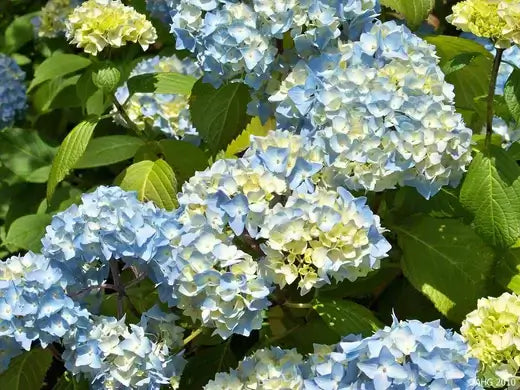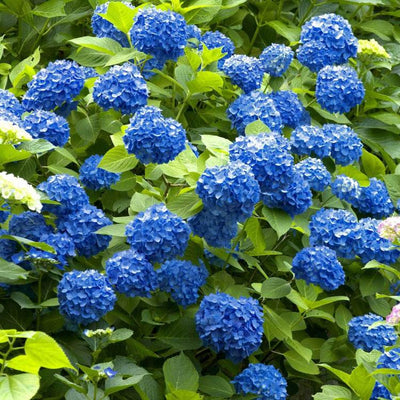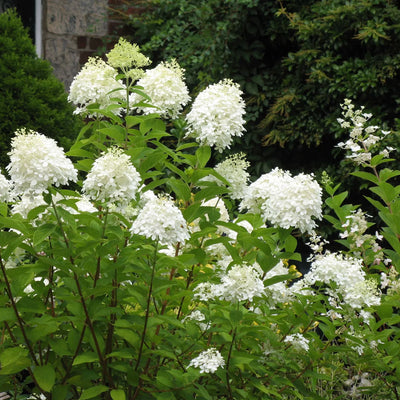The Mystery of Hydrangeas and their Transformations
Few things are as spectacular and breathtaking as gazing out of a window and witnessing the colorful creations in full bloom of the magical hydrangeas. These hydrangeas are a must have for any garden and the perfect way to bring your garden to life. Hydrangeas will be your most reliable plant as they come back every year and in full bloom.
These magnificent displays are so beautiful and spellbinding that many people wonder and have a great admiration for these plants. I also once thought the same way. I thought my hydrangeas could never thrive because of the hard clay soil I had. However, I had a simple cutting of my mother-in-law's plant and a year later, they took root and flourished. Then, I found out that clay soil is very easy to work with. Hydrangeas can amaze anyone, as their great beauty and foliage are a true testament of the resilience of these plants.
The loveliness of a hydrangea is obvious, but did you know that they can change color? Have you ever looked at your neighbor's deep blue hydrangea while yours is a brilliant pink? Why does that happen? Well, it does not depend solely on the variety of the hydrangea; it also depends on the science of your soil. This text will tell you some secrets about the colors of hydrangeas, how to change them, and how to keep these beautiful additions to your garden alive.
Explaining the Chemistry of the Soil and Hydrangeas
Some varieties of hydrangeas, mainly the Bigleaf (Hydrangea macrophylla) and the Mountain Hydrangeas (Hydrangea serrata), have their colors determined by the pH of the soil. It is a science experiment of sorts happening right in your garden. The aluminum some soils contain is the factor in color change.
The reason the soil is of a certain color is because the hydrangea is able to take in the aluminum from the soil.
For Blue Blooms
To get the rare shades of the sky blue, cobalt, and deep indigo for blue blooms, the plant needs to absorb aluminum which is abundant in acidic soils, mostly below a pH of 6.0. Under acidic conditions, aluminum in the soil becomes available for uptake by the plant's roots, resulting in the formation of blue flowers.
For Pink Blooms
To get the desired shades of soft pink, rose, and magenta in the pink blooms, one needs to stop the plant from absorbing aluminum. This is achieved by getting the plant to grow in alkaline or neutral soils, pH above 7.0. In the higher pH ranges, the aluminum becomes "locked up" in the soil, and is unavailable to the plant. This allows the pink pigments in the flowers to be more concentrated and shine through.
For Purple or Mixed Blooms
What about the beautiful purple or mixed blooms? This includes violet, lavender, and bushes that have a collection of both pink and blue flowers. This is achieved when the soil pH is in the transitional range, mainly between 6.0 and 7.0. In this case, the plant is taking in a moderate amount of aluminum, and this results in a beautiful collection of mixed colors.
Finally, it is worth noting that the white hydrangeas, especially the widely loved 'Annabelle' or Oakleaf varieties, will not have their color changed. The blooms will remain white, and this is the case, no matter the pH that the soil has.
Popular Hydrangea Varieties for Your Garden
When thinking of hydrangea species with color-changing blooms, one always thinks of Bigleaf hydrangeas, but have in mind that hydrangeas come with innumerable diversity in types, each with different foams, sizes and blooming patterns to suit different rai l patterns and climatic conditions on your garden.
Bigleaf Hydrangea (Hydrangea macrophylla)
This variety exemplifies the classic look and colorchanging blooms of Bigleaf with a large mop-head of dome shaped flowers to flat lacecap clusters. One of the examples of Big Blue is Nikko blue that towers up to between 4 and 6 ft. wide. This variety does well in partial sunlight and is in growing zones 6-9.
Panicle Hydrangea (Hydrangea paniculata)
With conical shaped flowers, this variety is one of the hardiest to grow. Mid-summer the flowers of all varieties such as 'Limelight' and 'Vanilla Strawberry' which start ???? ripened to white and in the autumn turn to dark red. They do well in the sun with less shade compared to Bigleaf.
Oakleaf Hydrangea (Hydrangea quercifolia)
With large oak-leaf shaped foliage, this species is originally grown in the southeastern corner of the United States. In autumn, the large foliage turns to vivid red and purple. The age of the white flowers in conical clusters that turn dusty pink in color is noticeable. This is the perfect selection if you are looking to provide four-season interest.
Smooth Hydrangea (Hydrangea arborescens)
The most common type is the 'Annabelle' type, known for its large, perfectly rounded, white flower clusters. After a tough winter, it surely takes the crown for reliability, still blooming every spring!
Companion Plants to Complement Your Hydrangeas
While a single hydrangea by itself certainly makes for a breathtaking centerpiece, planting a few more perennials around it can take the beauty to the next level. The more plants, the more color, style, and texture you can bring to the flower bed! When selecting, pick the plants that will grow and thrive together and in the same conditions. Hydrangeas love partial shade, and moist, well-drained soil.
Hostas along with the hydrangeas are the most popular pairing. The hostas have big, textured leaves that come in a variety of colors and contrast nicely with the hydrangea flowers. Ferns are a great option to have with hostas and hydrangeas too. A few good ones are the Japanese Painted, or Lady Fern that add a very soft, textured contrast to the hostas and large hydrangea leaves and flowers.
Astilbe is a great option for this as it is a good option to add flowers with color. In early summer, it sends feathery plumes of bright pink, white, and red flowers. Coral Bells (Heuchera) are also a good pick, and have very pretty, varied color leaves that can match the color of the hydrangea flowers!
Find Your Favorite Plants at TN Nursery
If you want a border of dazzling blue flowers or a gorgeous pink flower, we have the correct plants for you. All gardens need healthy, quality plants.
TN Nursery is devoted to assisting you with your favorite designs. From a changing color Nikko Blue to an Oakleaf, there is a huge selection of hydrangeas. Plus, there is an assortment of perennials and shrubbery. Visit us online today and we will assist you.
FAQs
How do you change the color of hydrangeas?
There are soil amendments to help change the color of some hydrangeas. To change a hydrangea from a baby pink, onto blue, incorporate a soil acidifier such as ammonium sulfate, or aluminum sulfate. To change them from blue to a baby pink, and to change the flower color of a pink hydrangea, you need to raise the soil acidity by incorporating a garden lime. This can take time, so do not expect instant results.
What are all the types of hydrangeas?
There are six major types of hydrangeas that are commonly grown in North America. They are the Bigleaf, Panicle, Smooth, and Oakleaf x Climbing. And the Climbing and Mountain Cuttings as well as the Mountain. Each of them have different shapes and sizes, as well as more of a unique color and climate zone.
What are the two colors of hydrangeas?
Even though hydrangeas come with a variety of colors, and shades, the two mostly found are either blue or pink. They can also change color, as well as have a non-changing color. White hydrangeas are common, and do not change. And purple as well as green can also be displayed depending on the particular cultivar.
Is the color hydrangea blue or purple?
The color/ shade of the hydrangeas can either be purple or blue, based on the soil chemistry. A hydrangea will produce purple flowers in soil that is slightly acidic or neutral and the plant can absorb some aluminum, but not a lot of it. Blue flowers are produced in soil that is highly acidic with more available aluminum.
Do coffee grounds change hydrangea color?
Coffee grounds are known to make soil a little acidic when they decompose, which is a step in the right direction for a pink hydrangea to change towards purple or blue. That said, the coffee grounds are not a quick or reliable solution to the problem. A more direct and fast-acting solution is to either use aluminum sulfate which is a soil acidifier.
What do you do with hydrangeas in October?
You are welcome to let the flowers dry on the plant in October. This not only creates a unique, decorative touch to the garden but is also a good chance for you to make sure the plant is well watered before the soil can freeze, especially if it's recently been planted. Try not to do a lot of pruning in the fall with big leaf hydrangeas. You may be cutting off the blooms for next year as they bloom on the old wood.




